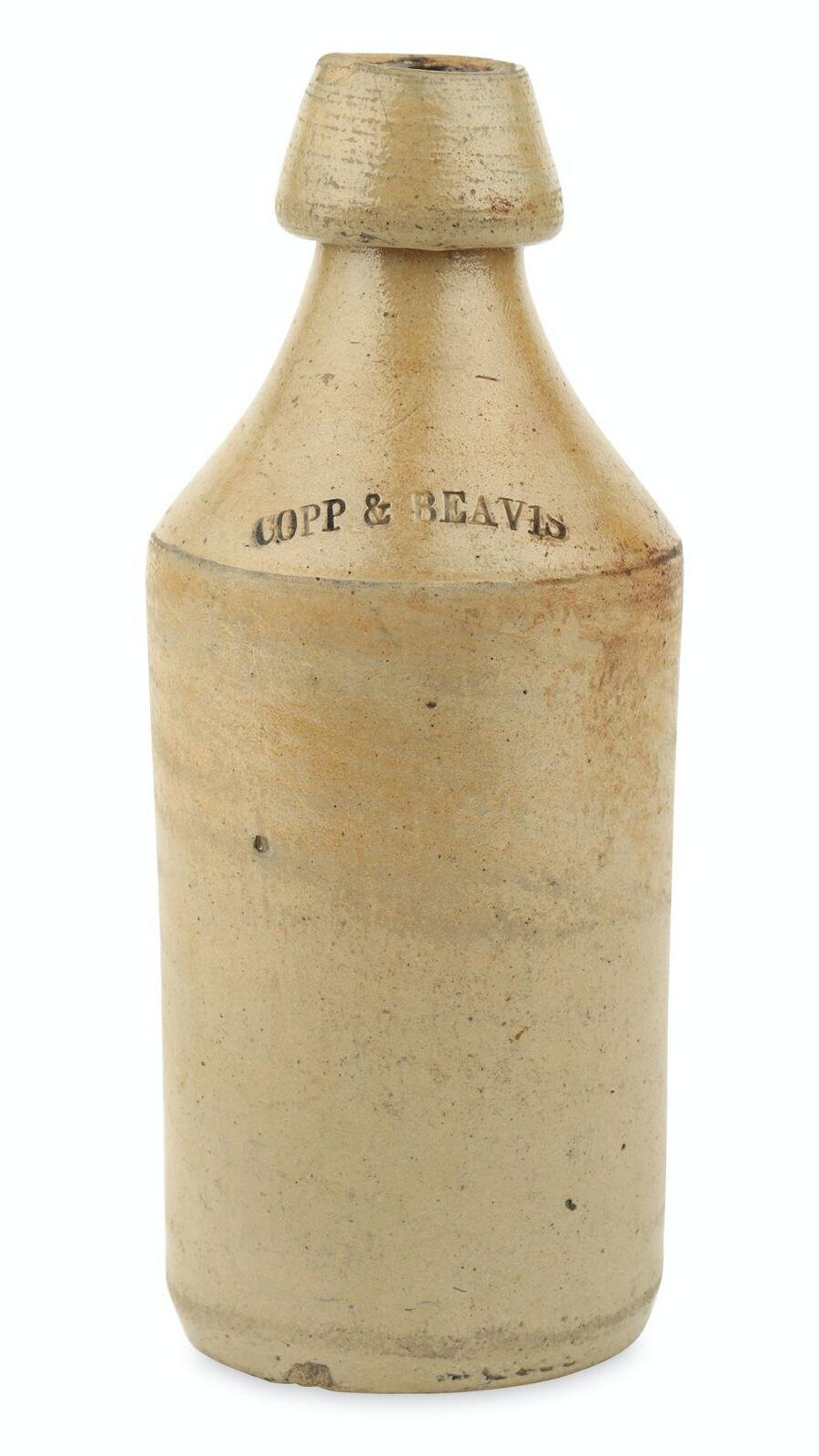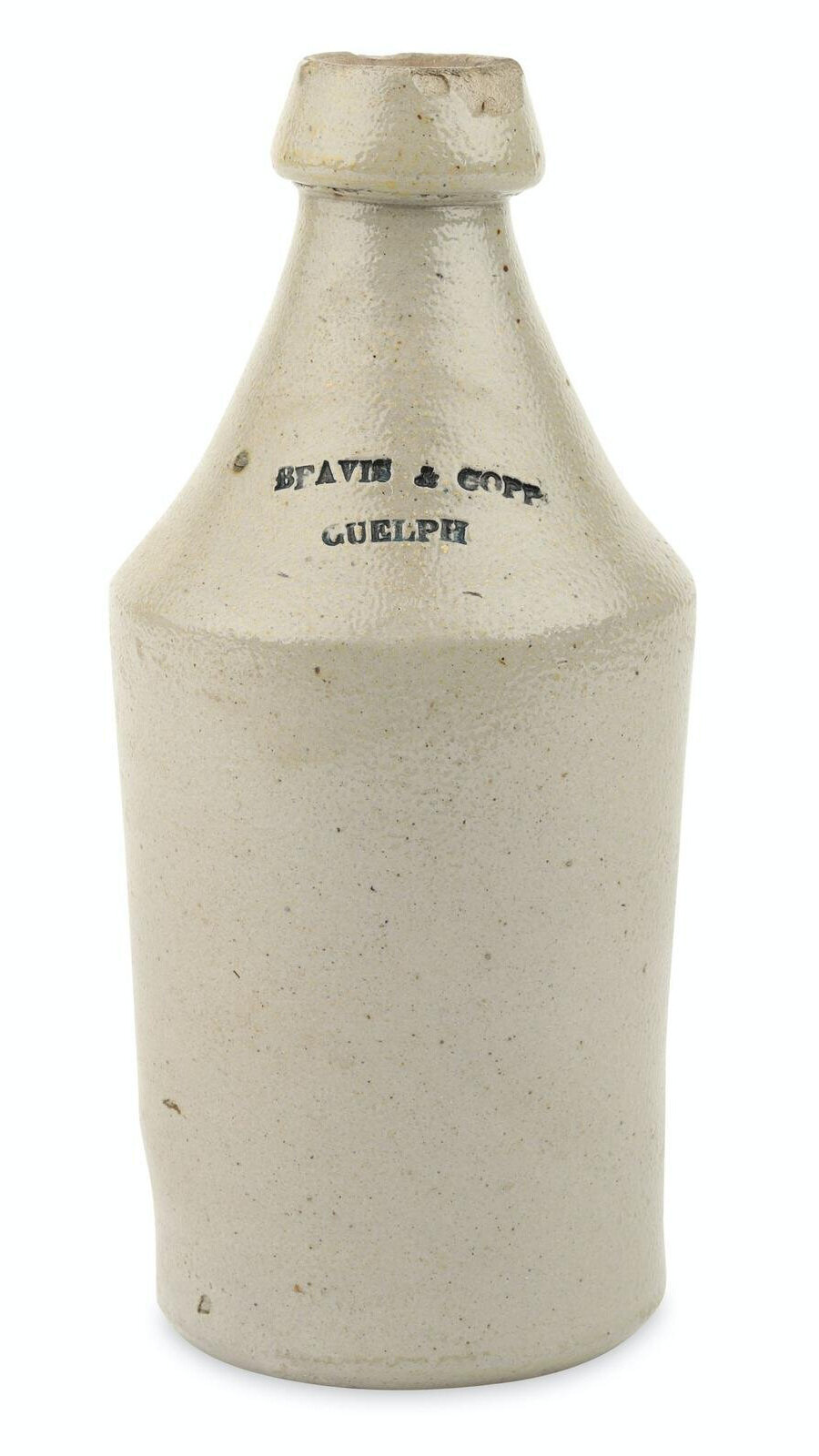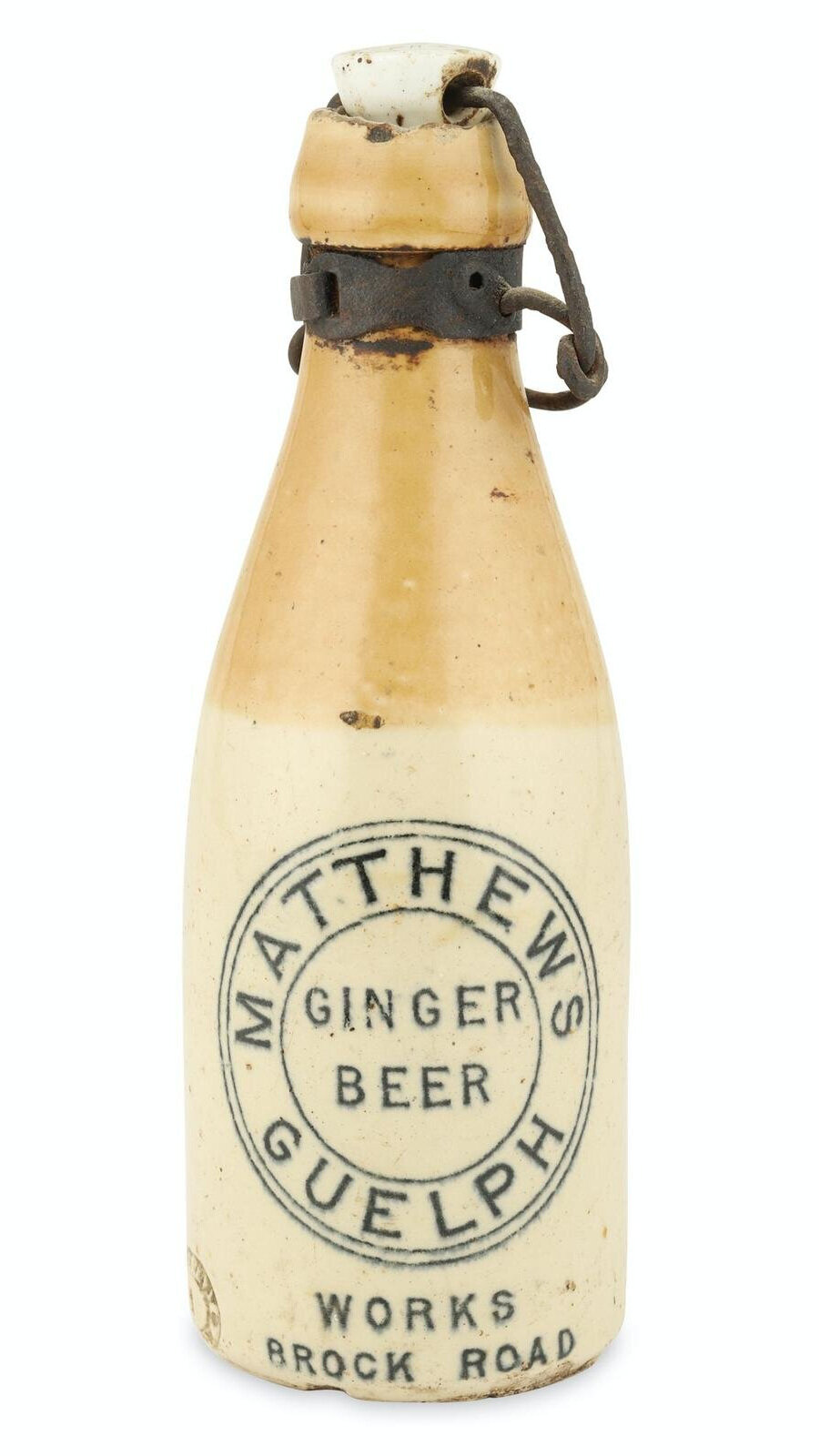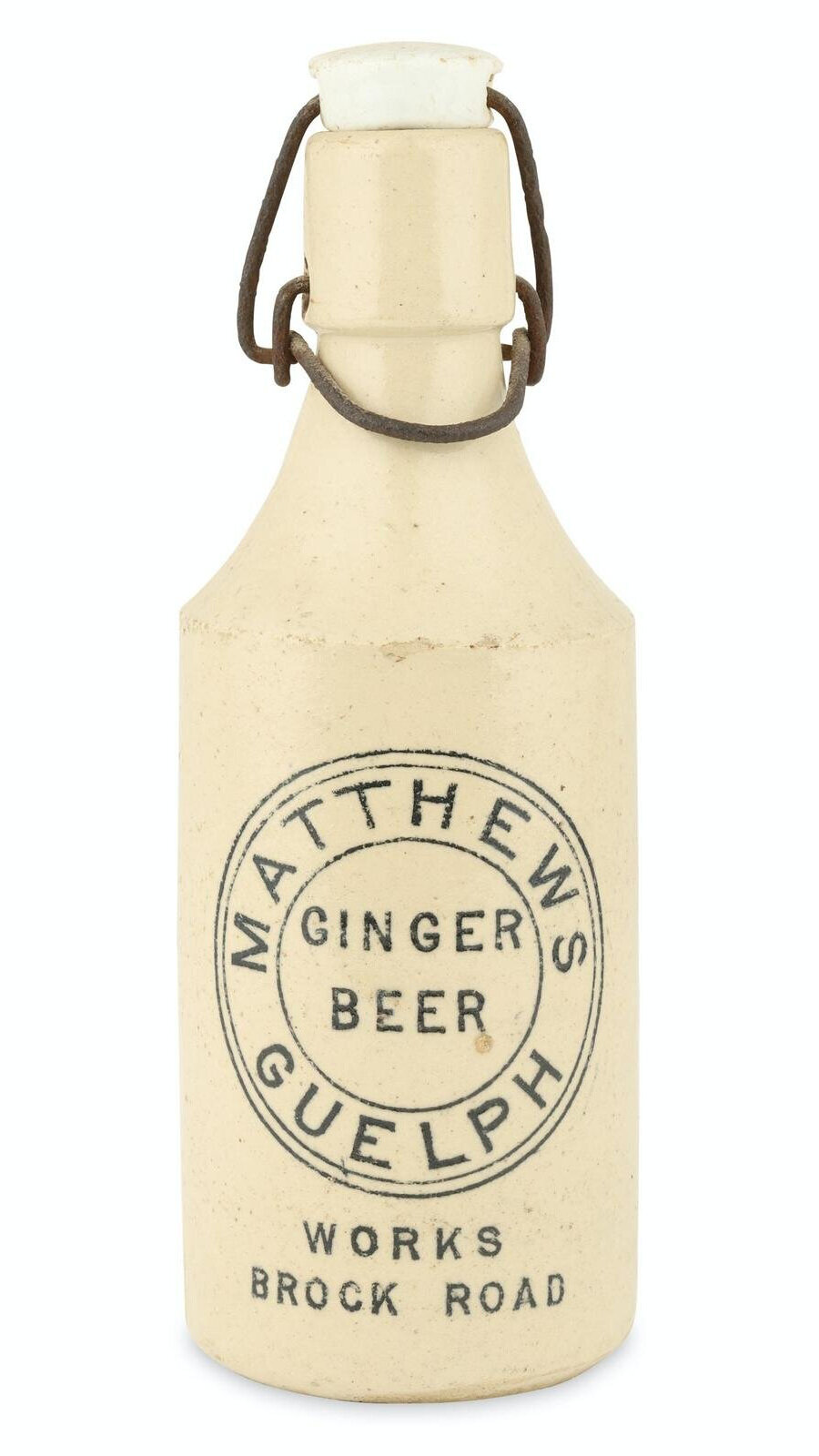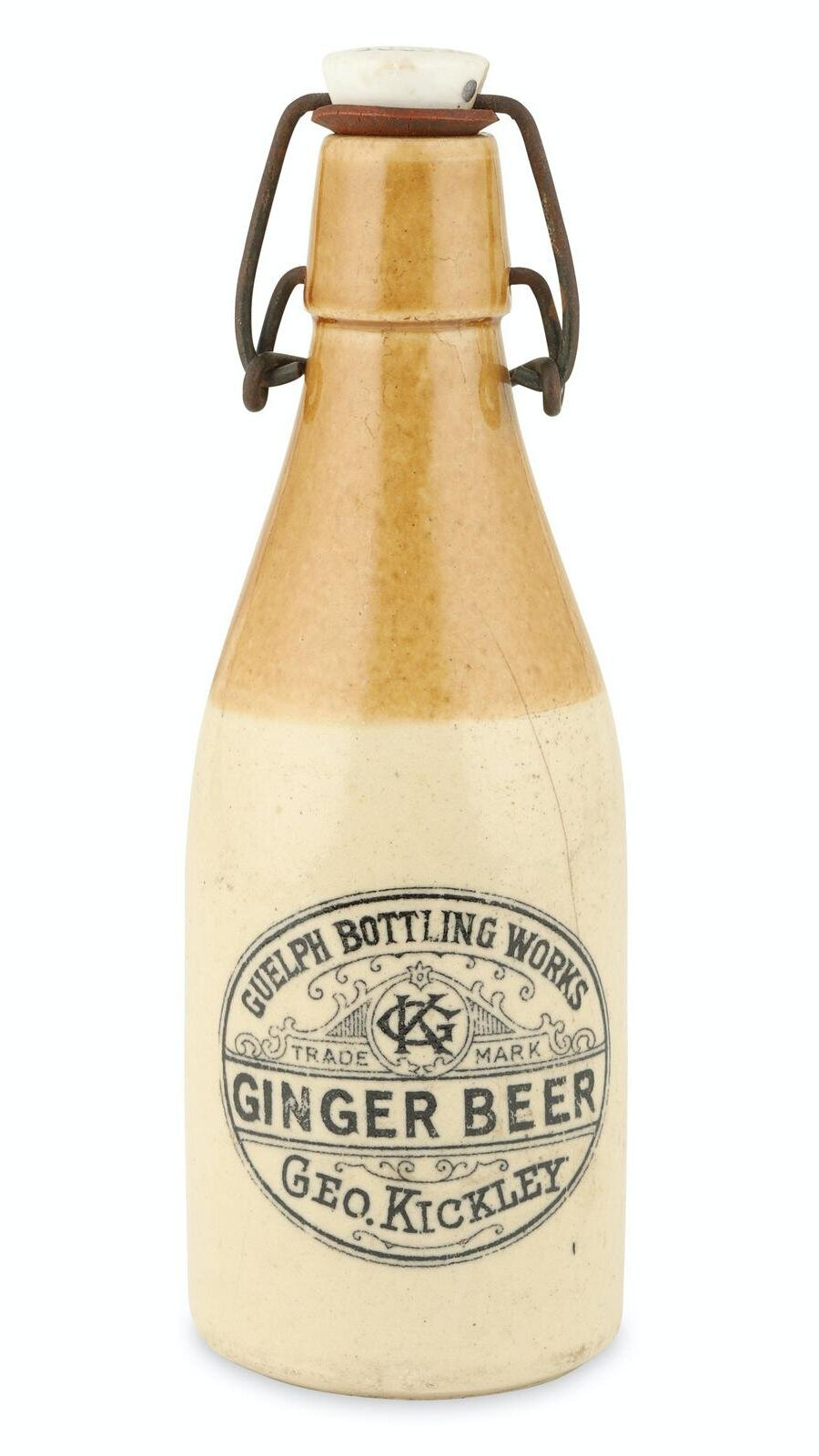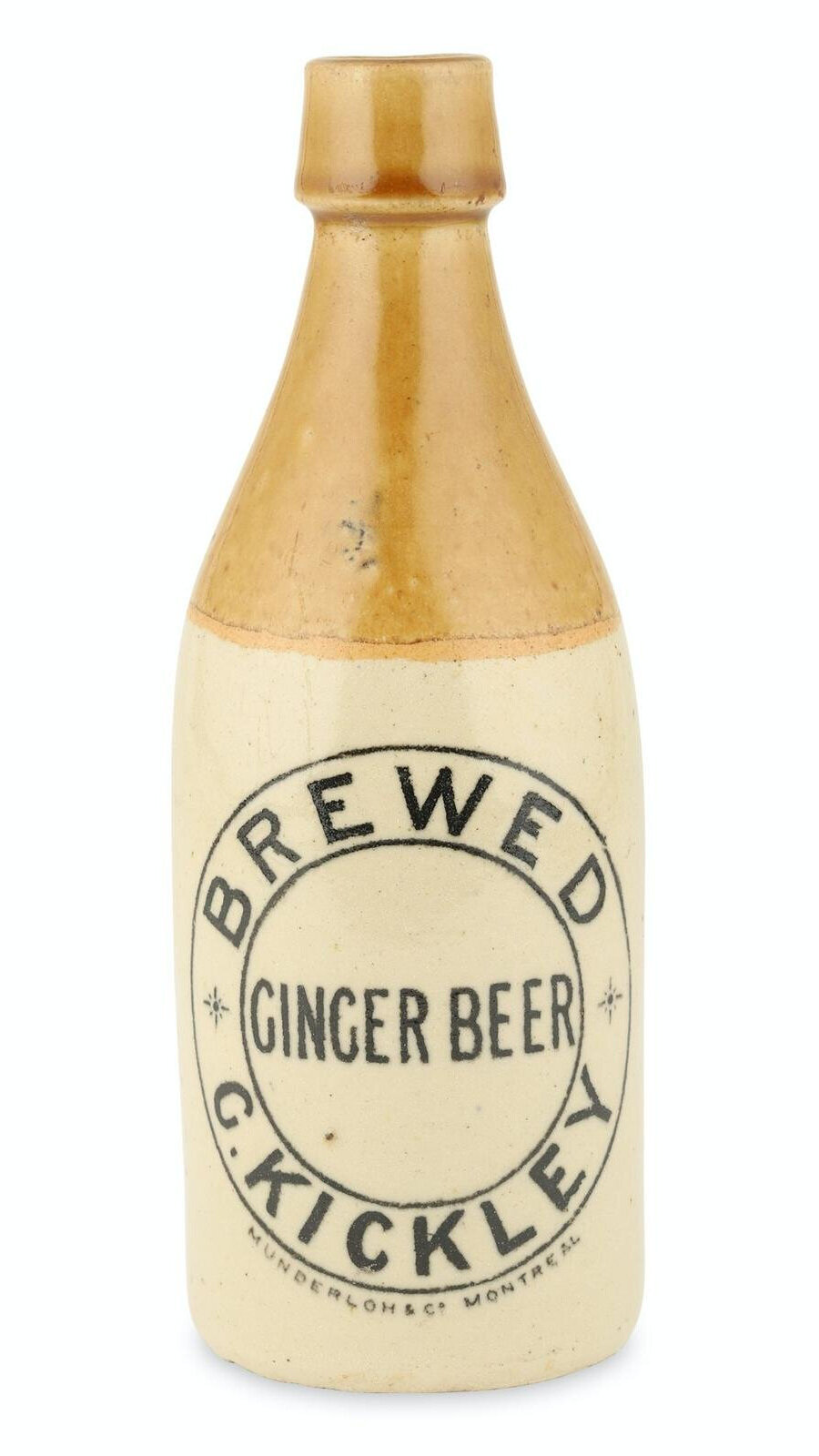The Guelph Ginger Beer Bottles
The Blyth ginger beer collection comes to market
This story originally appeared in the July 1988 edition of the Antique Showcase magazine. It is re-printed with permission from the authors Joyce Blyth and Scott Jordan.
William Atkinson was a beverage bottler of long standing in Guelph, operating from 1861 to 1899, taking over the business of Thomas Atkinson - first at part lot 110 Macdonell Street and later at 52 Liverpool Street. Impressed in the early hand-formed blob top bottle (lot 267) is “W. Atkinson, Guelph C.W.”. The blue stamping on the cream coloured bottle in the centre (lot 259) reads “W. Atkinson, Ginger Beer, Guelph.” Impressed into the clay at the bottom of this latter bottle (lot 260) is the name of the Scottish bottle manufacturer - H. Kennedy, Barrowfield Potteries, Glasgow.
The collecting of stone ginger beer bottles is a well established and growing hobby that is at the present time receiving a great deal of renewed interest. Among the many collectable bottles, those used by the Guelph bottlers are eagerly sought and treasured by collectors. In style and manufacturer, the Guelph bottles are not unlike the type found throughout the province, but for some unknown reason, finding a Guelph ginger beer bottle of any name is difficult.
The early ginger beer bottles used in the 1850s and 1860s were hand formed with the name of the drink manufacturer often incised as a lasting advertisement into the pottery In the neck area. Because they were hand made, the capacity of the bottles varied from approximately nine ounces to 14 ounces. The closure of the primitive bottles was a cork held by a wire anchored around the blob top. The later machine-made pottery bottles had a label or design stamped with the brewer’s name in black print, or sometimes in blue, under the translucent glaze. Different methods were used to seal the contents of these bottles depending on the style of bottle top. With the invention of the lightning stopper in 1875, the bottling industry had a new practical closure. The lightening stopper, used on collar top bottles, consisted of a wire bale holding secure a rubber ringed porcelain stopper. There are other variations on closure, but most utilized the basic principles of a rubber ringed stopper and some type of wire bale. The crown top, a cork-lined metal cap, patented in 1891, eventually made all other closures obsolete. The closure was essentially the same as those on beverage bottles today.
A great number of the ginger beer bottles used by Canadian manufacturers were ordered and shipped from pottery companies in England and Scotland. Ceramic industries there were well established to the point that American potters could not successfully compete. Pottery bottles were quite heavy and because of this characteristic they were popular with the masters of shipping vessels as ballast. Ships returning after delivering cargo to Europe often sailed with partially filled holds and so there was always an interest in shipments of heavy goods.
Manufacturers reused the stoneware bottles. These durable containers were seldom broken and survived many trips from the bottler to the consumer and back again. The pottery was thick, the bottles were heavy and were most often delivered in wooden cases. The product was sold within a limited area through grocery stores, soda fountains, hotels, clubs and the like.
Why did some manufacturers refer to the beverage as stone ginger beer? Why was the drink contained in stoneware? Was it because stoneware was considered stronger than glass or because stoneware kept the contents at a cooler temperature and shielded the ginger beer from the light? Perhaps pottery bottles had disadvantages also - they were difficult to fill by sight, it was difficult to determine how much substance remained in them and it was difficult to ensure their cleanliness for reuse. Unlike other stoneware utility vessels, which were phased out around the turn of the century with the rise of the glass industry, the use of stone ginger beer bottles continued until well into the 1920s. It was probably due to health standards that the pottery bottles were finally disposed of.
What makes the collecting of these named artifacts so stimulating and rewarding is the fact that through a study of assessment rolls, census records, directories and period newspapers it is possible to find the location of the manufacturers and the date in which they operated. This allows the collector to more accurately pinpoint the origins of a particular piece, which in turn can enhance its value.
The popularity of antique collecting has increased very rapidly in the last decade and the pace is accelerating. There are undoubtedly many complex reasons for this, one being the investment motive with the widespread belief that antiques and collectables are a relatively stable commodity. Generally speaking, collectables of first-rate quality, which good named ginger beer bottles are categorized as, have shown percentage gains in value over the last few years considerably greater than have mediocre or commonplace antiques.
Ginger beer, a beverage flavoured with fermented ginger root, was a favourite drink in England at the beginning of the nineteenth century and later in America as a substitute for real beer. During prohibition ginger beer was one of the so-called temperance brews, although lightly fermented with an approximate two percent alcoholic content. Because of its taste and the fact that it had a head, it was more a beer than a wine. This fashionable beverage of the day began to lose its popularity to other flavoured drinks around the time of World War 1 (1914-1918).
Some of the oldest known of the Guelph ginger beer bottles are those used by George Beavis and James Copp. Shown are two blob top hand-made bottles marked “Beavis and Copp, Guelph” varying in capacity from nine ounces to twelve ounces. From 1857 to 1863 the Beavis and Copp partnership operated on Kent Street in the town of Guelph. (All bottles from the Blyth collection)
Between 1859 and 1862 James Copp (of Beavis and Copp) had his own establishment at Lot One on Woolwich Street. According to the 1861 census his annual production was 3000 gallons of ginger wine, etc. “James Copp, Guelph” is the wording impressed in his stoneware bottles. These bottles, although similar, have a two ounce capacity difference.
From 1873 to 1906 Alex Matthews manufactured ginger beer and carbonated beverages at 247 Brock Road in Guelph. Similar markings on both bottles read, “Matthews, Ginger Beer, Guelph, Works Brock Road.” The Kennedy potters of Glasgow produced the two Matthews bottles.
Reed Brothers took over the Alex Matthews bottling works in 1906. A short two years later in 1908, the business was dissolved. The Reed ginger beer bottle is different from the others in that the labelling is printed in blue and reads, “Reed Bros., Ginger Beer, Works Dundas Road, Guelph. This bottle must be returned when empty.”
In 1908 Albert Reinhart purchased the Reed Brothers beverage business and continued until 1971 to manufacture drinks. “Royal City Mineral Water Works, A. Reinhart, Guelph” is the wording in a circle around the Reinhart logo. Kennedy of Glasgow was also the maker of the Reinhart bottle. To clarify the confusion of the addresses of the three related industries operating from the same location we might add that the street name was changed at different times throughout the years, starting with Matthews at Brock Road, Reed at Dundas Road and finally Reinhart at Gordon Street.
Ginger beer and other pops were produced from 1901 to 1920 by George Kickley, Guelph Bottling Works. His first business was operated from 20 Powell Street and in 1917 he was listed as operating at 17 Robinson Avenue. It is believed that George Kickley also brewed ginger beer for John Thompson of Hamilton. Two variations to the Guelph Kickley bottles are known to exist. The very plain lettering on the bottle at the left reads “Brewed Ginger Beer, G. Kickley.” Marked under the label is Munderloh and Co. Montreal, the maker of the bottle. The bottle at the right, referred to as the fancy Kickley, has the most elaborate design of any of the Guelph ginger beers and reads, “Guelph Bottling Works, Ginger Beer, Geo. Kickley.”
“Ye Olde English, Stone ginger Beer, was made by James Ryder, Mineral Water Manufacturer, Guelph, Ontario. This bottle must be returned or paid for” is the inscription on the bottle used by James Ryder. Throughout his time in operation, 1910-1937, Ryder manufactured drinks at a number of different locations in Guelph. From his first location at 104 Dublin Street he moved to 14 London Road, then to the Masonic Temple building on Quebec Street, on to 58 Clinton Street and finally at 175 Queen Street.
Auction Details:
Canadiana & Sporting
The Don & Joyce Blyth Collection
June 5, 2021
Did you enjoy this story? Feel free to share it using the buttons below:


